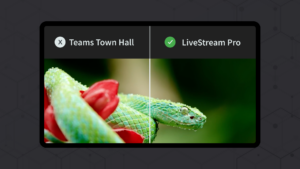What is an eCDN?
An Enterprise Content Delivery Network (ECDN) is software or hardware that optimizes the delivery of bandwidth-intensive content such as video or software.
When many users are trying to access the same bandwidth-intensive content at the same time (e.g. all hands meetings, town halls, employee speeches or training), enterprise networks struggle to meet demand, which can lead to the failure of business-critical applications, buffering and network collapse.
What are the benefits of CDNs?
Content Delivery Networks are used to save bandwidth by intelligently managing how content is distributed to devices on your network. The increasing use of video to deliver important messages has made eCDNs a necessity for the majority of businesses.
Video streams consume a lot of bandwidth – high-quality, interactive streams even more. Without an eCDN, repeated high-bandwidth requests can overload your corporate firewall and slow down or crash your network.
CDNs are typically shared by thousands of organizations and users. eCDNs bring content distribution behind the firewall, allowing for better control over security protocols and the flow of content across your network.












